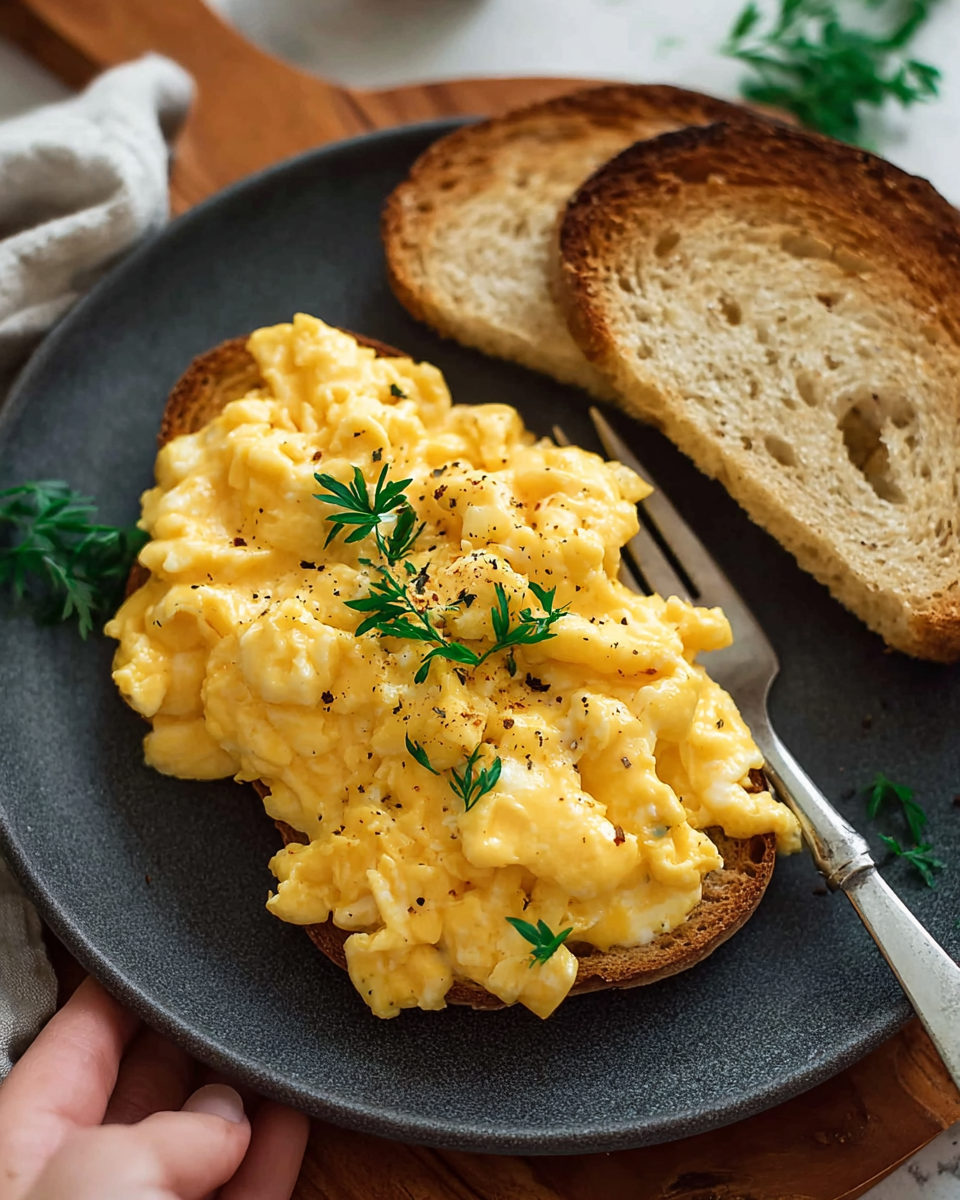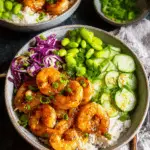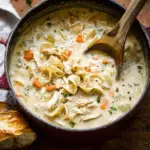The beauty of these scrambled eggs lies in their simplicity. Whisked with just a touch of milk and lovingly folded in a warm buttered pan, they turn into silky ribbons of golden custard. These aren’t your cafeteria eggs — they’re the kind that glide onto toast with elegance and taste like a morning hug. Served on thick slices of crusty, buttered artisan bread, these scrambled eggs are light yet rich, delicate yet deeply satisfying. Whether it’s a quick weekday breakfast or a leisurely weekend brunch, this dish delivers creamy comfort in under five minutes. Mastering this technique will instantly elevate your egg game forever.
Full recipe:
Ingredients:
-
4 eggs
-
2 tablespoons milk (optional, for added creaminess)
-
1 tablespoon unsalted butter
-
1/4 teaspoon salt
-
2 grinds fresh black pepper
-
4 slices crusty bread, toasted and buttered (optional for serving)
Directions:
-
In a mixing bowl, whisk together eggs, milk, salt, and pepper until fully combined and slightly frothy.
-
Heat butter in a non-stick skillet (about 10″) over medium heat. Let it melt completely without browning.
-
Pour the egg mixture into the skillet and wait 5 seconds for the base to begin setting.
-
Using a rubber spatula, slowly push the eggs from one side of the skillet to the other in long, slow strokes, including the edges. Avoid rapid stirring.
-
After 30 seconds, start gently folding the eggs to form soft curds. Continue for another 30 seconds or until there’s no raw egg leaking but the texture remains moist and custardy.
-
Remove from heat and fold gently for an additional 10 seconds to finish cooking with residual heat.
-
Serve immediately on toasted bread, garnished with a light sprinkle of extra black pepper or a sprig of curly parsley.
Prep Time: 5 minutes | Cooking Time: 1 minute | Total Time: 6 minutes
Kcal: 182 kcal | Servings: 2
The Art of Perfect Creamy Scrambled Eggs
Scrambled eggs are often one of the first dishes we learn to cook, but ironically, they’re also one of the easiest to get wrong. What seems like a basic breakfast staple is actually a delicate process of heat control, patience, and technique. When done right, scrambled eggs transform into something far beyond mere nourishment — they become luxurious, creamy, and comforting.
Perfect creamy scrambled eggs, often referred to as “custard-style” scrambled eggs, are light, soft, and slightly glossy. This technique is not new; in fact, it’s a time-honored method used by chefs around the world, particularly in France and upscale diners where eggs are treated with reverence. When you follow the slow-and-low technique combined with gentle folding, you get eggs that are tender and elegant rather than dry and rubbery.
This recipe is not just for breakfast. These scrambled eggs are so versatile and quick to prepare, they make a great lunch, brunch, or even dinner option. With only a handful of ingredients and a little finesse, you can enjoy a restaurant-quality dish right in your kitchen.
Why These Scrambled Eggs Stand Out
There’s a good reason food bloggers, chefs, and home cooks obsess over scrambled eggs. They’re deceptively simple but incredibly telling of a cook’s technique. This version focuses on achieving soft, custard-like curds by using a few precise strategies:
- Low heat: This prevents the proteins from overcoagulating, which is what makes eggs dry and rubbery.
- Gentle folding: Rather than stirring or whisking in the pan, the eggs are slowly pushed and folded using a rubber spatula to form tender, silky curds.
- Residual heat cooking: Eggs cook incredibly fast. By removing them from the stove just before they’re fully set, you allow carryover heat to finish the job, leaving them perfectly moist.
Another reason this recipe shines is that it’s adaptable. While the classic version includes butter, eggs, a splash of milk, and seasoning, you can easily build on it with herbs, cheese, sautéed vegetables, or smoked salmon. The technique remains the same — gentle and respectful of the ingredients.
Nutritional Value and Health Benefits
At first glance, eggs may seem like a humble ingredient, but they’re actually one of the most nutrient-dense foods you can eat. A single large egg contains:
- 6 grams of high-quality protein
- Vitamins A, D, E, B12
- Choline (essential for brain health)
- Selenium and iodine
- Healthy fats, including omega-3s (especially in pasture-raised eggs)
Scrambled eggs cooked with minimal butter and milk provide a balanced meal with healthy fats and essential amino acids that support muscle growth and overall health. For people following a low-carb, high-protein, or keto-friendly diet, this dish is an ideal fit. It’s filling, nourishing, and supports stable blood sugar levels when paired with whole grain or sourdough toast.
If you’re trying to keep calories in check, simply skip the toast or use low-fat milk. Alternatively, you can serve the eggs over sautéed greens or avocado slices for a low-carb variation.
The Role of Ingredients in Achieving Perfection
Not all eggs are created equal. The quality of your eggs plays a huge role in both taste and texture. Organic or pasture-raised eggs typically have richer, more vibrant yolks due to the chickens’ diet and lifestyle. These yolks contribute not only better color but also a deeper, richer flavor.
Milk in this recipe is optional, but it adds creaminess and moisture to the eggs. Just ½ tablespoon per egg is enough — any more, and your eggs may turn watery. Some people prefer using cream instead of milk, but this can be a bit too rich for everyday consumption. Water is sometimes used, but it doesn’t emulsify as well and can produce inconsistent results.
The butter does double duty: it greases the skillet and adds a subtle depth of flavor. Use unsalted butter for more control over seasoning, or try ghee for a nutty, clarified option.
Salt and pepper may seem like an afterthought, but they’re crucial. Salt enhances flavor and slightly loosens the egg proteins, making them more tender. Fresh cracked black pepper adds a nice balance to the richness of the eggs.
Common Mistakes to Avoid
Perfect scrambled eggs demand care and attention. Here are common pitfalls to avoid:
- Cooking on high heat: This is the most common mistake. High heat can scramble the eggs too quickly, leading to a dry, rubbery texture.
- Over-stirring: Frantic stirring breaks the eggs into tiny pieces, eliminating the possibility of soft curds. Gentle folding is key.
- Waiting too long to remove from heat: Eggs continue to cook even after they’re off the burner. Timing is everything; take them off when they’re still slightly glossy and underdone.
- Using the wrong pan or utensil: A nonstick pan is best, paired with a rubber spatula. This combo ensures the eggs don’t stick and allows for smooth movement.
Pairing Ideas for a Full Meal
Though these scrambled eggs can shine on their own, they pair beautifully with a range of breakfast sides:
- Toasted sourdough or artisan bread slathered in butter
- Sautéed mushrooms with garlic and herbs
- Avocado slices with a drizzle of olive oil and lemon
- Grilled tomatoes for a sweet and savory balance
- Smoked salmon or turkey bacon for added protein
- Fresh fruit salad for a bright contrast
If you’re feeling indulgent, top the eggs with grated cheese (cheddar, feta, or Parmesan) or a dollop of crème fraîche for a luxurious twist.
Cultural Notes and Variations Around the World
Scrambled eggs are a global favorite, but preparation styles vary:
- French scrambled eggs (œufs brouillés) are stirred constantly over very low heat, sometimes in a double boiler, and often finished with cream or butter.
- British scrambled eggs are usually firmer and served with beans or sausages.
- Chinese tomato scrambled eggs feature lightly scrambled eggs with stir-fried tomatoes and scallions.
- Indian masala eggs are scrambled with onions, turmeric, chilies, and spices for a bold, flavorful dish.
The creamy scrambled eggs in this recipe lean toward the French technique but are simplified for daily home cooking.
Why This Recipe Belongs in Every Home Cook’s Repertoire
Whether you’re a novice cook or a seasoned chef, mastering scrambled eggs is a milestone. It sharpens your ability to control heat, timing, and texture — three pillars of great cooking. Once you’ve perfected this dish, you’ll never go back to overcooked, rubbery eggs.
Moreover, it’s a recipe that scales beautifully. Making breakfast for one? Just use two eggs. Feeding a family of four? Quadruple the batch and use a larger pan. It’s cost-effective, quick, and endlessly customizable.
This recipe also teaches you respect for ingredients. By treating eggs gently and taking your time, you bring out their natural richness and flavor. There’s a quiet elegance in a simple dish done exceptionally well.
Conclusion
Perfect creamy scrambled eggs are more than just a breakfast dish — they’re a celebration of simplicity and skill. With minimal ingredients and a few mindful techniques, you can transform a basic meal into something luxurious and deeply satisfying. This recipe is a testament to the power of slow cooking, careful heat control, and quality ingredients.
Whether served on toast, paired with other brunch favorites, or eaten straight from the pan, these scrambled eggs are bound to become a staple in your kitchen. Once you’ve experienced how light, fluffy, and creamy they can be, you’ll never settle for rushed, overcooked eggs again. Try it once, and you’ll see why this technique is the gold standard in kitchens around the world.






